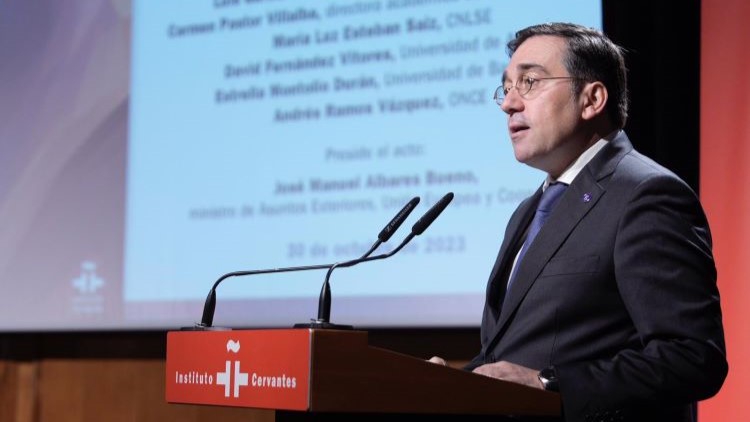Eduardo González
Fifteen percent of Europeans are able to communicate in Spanish, which has become the fourth language in the EU by number of native speakers, after German, Italian and French, and by the number of people who have it as a second foreign language, according to the Yearbook 2023 Spanish in the World, prepared by the Instituto Cervantes.
Spanish is the second language in the world by number of native speakers (with nearly 500 million) and is the second language of international communication, according to the report, presented yesterday at the Institute’s headquarters in Madrid. If to this figure are added the more than 23 million students who study Spanish as a foreign language and the more than 76.4 million users of the language with limited proficiency, the total number is almost 600 million people, equivalent to 7.5% of the world’s population. “We are the second language in the world after Mandarin Chinese,” said the director of the Instituto Cervantes, Luis García Montero, during the presentation of the event.
“Sharing the language with almost 600 million people in the world brings us closer and allows us to participate in a diverse cultural space,” said, for his part, the acting Minister of Foreign Affairs, José Manuel Albares, during the closing of the presentation. “The data are eloquent and show us that our language is a heritage of immense value, a heritage that we have to take advantage of as a tool to create closer ties between countries, at this time when peace is so threatened in Gaza or Ukraine,” he said.
For this reason, “the promotion of Spanish is one of the key axes of the foreign policy that I direct and, for this reason, one of my first decisions as minister was to incorporate the dimension of Spanish in the world within the Ministry,” Albares told the audience, which included the Secretary of State for Ibero-America and the Caribbean and Spanish in the World, Juan Fernández Trigo, and the Special Commissioner for the Alliance for a New Economy of Language, Cristina Gallach.
In any case, the report warns that, although the Spanish-speaking community will grow in absolute terms over the next fifty years, its relative weight will gradually diminish between now and the end of the century, mainly due to a drop in the birth rate in Spanish-speaking countries, which will definitively hand over to other regions of the planet, such as sub-Saharan Africa or Central and South Asia, as drivers of world population growth. In 2100, only 6.4% of the world’s population will be able to communicate in Spanish.
The report devotes a special chapter to the United States, which in 2060 will be the country with the second largest number of Spanish speakers in the world, after Mexico. Estimates made by the U.S. Census Bureau indicate that, in that year, there will be 111 million Hispanics distributed throughout the country. That will mean that 27.5% of the U.S. population, almost one out of every three U.S. residents, will be Hispanic.
The EU
“There is a fact that is perhaps less well known, but which is very relevant at this time when we hold the Presidency in the Council of the EU: Spanish is already the second most studied foreign language in higher education in the Union, after English,” said Albares. “Some 76 million Europeans can communicate in our language; that is the strength of our common language,” he added.
In this regard, the Yearbook indicates that Spanish is the fourth language in the EU by number of native speakers (after German, Italian and French) and by the number of people who have it as a foreign language (after English, French and German). Specifically, almost 45 million Europeans speak Spanish as their mother tongue (ten percent of the 447 million inhabitants of the EU), another 25 million use it as a foreign language and more than six million are learning it. In total, some 76 million Europeans (around fifteen percent of the total EU population) are able to communicate in Spanish with varying degrees of proficiency in the language.
At the institutional level, Spanish is used as a working language in the Council and the European Parliament, but not in the European Commission, which has only three working languages (English, French and German), nor in the Court of Justice, whose only language of deliberation is French, although its language of procedure can be any of the 24 official languages of the Union. Furthermore, the Spanish interpreting staff is the third largest in the Commission’s Directorate-General for Interpretation.
However, according to the document, the general trend in the EU is to limit as far as possible the number of languages used in the Community institutions and “thus prevent multilingualism from becoming a hindrance to their functioning”. In principle, this limitation should be detrimental to Spanish, at least in the institutional sphere, since it would imply less use of this language in official documents and in institutional interpretations, but “a large part of European citizens” have opted to channel their efforts towards learning Spanish because of “its greater international projection” and because “it would be more useful for them to communicate outside the borders of the Union”.
Something similar is also observed in the case of the United Kingdom, where the study of Spanish has experienced a considerable upturn just after Brexit, to the detriment of French. Apart from this, within the EU the relative weight of Spanish as a mother tongue has increased due to the drastic reduction of the group of native speakers of English, which has gone from 13% to barely one percent, although, as the Yearbook warns, “the current functioning of the EU makes it practically impossible for English to cease to be an official language of the EU”.
For all these reasons, 5.3 percent of European citizens have decided to incorporate Spanish as a foreign language “over languages with a higher percentage of native speakers, such as Italian”.
As for European institutional communication through the Internet, an analysis of the number of visits to the European Union’s main information portal reveals a greater use of Spanish compared to other languages with a higher number of native speakers, such as German or French. English and, to a lesser extent, Spanish are over-represented on the network, in the sense that the proportion of visitors using these languages exceeds that of users from EU countries where these languages are official. This is probably due to the fact that many visitors who choose these two languages (particularly English) are outside the EU, which shows the greater international projection of Spanish compared to French and German.
On the other hand, English continues to be by far the most studied language, while Spanish competes with German for third place behind French. The figures for students enrolled in foreign language subjects in the various cycles of primary, secondary and vocational education during the period 2013-2020 reveal a clear upward trend in the study of Spanish, especially from 2016 onwards. In contrast, French and German seem to have reached their maximum number of students, as their numbers have hardly changed in the same space of time and, if the current trend is consolidated, the study of Spanish will surpass that of German before the end of this decade. Of the 27 countries belonging to the EU, France, Italy and Germany are the ones with the highest number of Spanish students.
In higher education, Spanish is in second place after English and ahead of French and German. In this regard, the Yearbook highlights that Spain is by far the country that receives the most Erasmus students. If we take into account that, according to the Erasmus students themselves, one of the main incentives for applying for these scholarships is the learning of other languages, “the data corresponding to Spanish indicates the enormous interest that this language awakens among European university students”.






